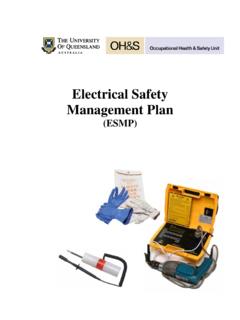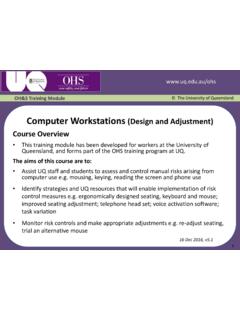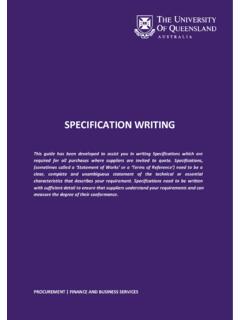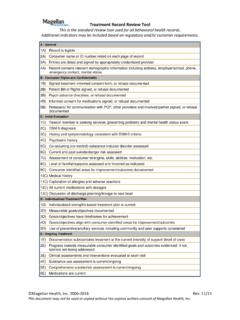Transcription of National self-insurer OHS management system …
1 National self-insurer OHS management system audit tool Version 3 Release Date: 4 August 2014 Next Review Date: 2016 Approval Status: Approved by Heads of Workers Compensation Authorities Prepared by: WorkCover NSW on behalf of the NAT Review Working Party ContentsIntroduction and history 2 audit criteria 4 Element 1: Health and safety policy Policy 17 Element 2: Planning Legal requirements and practical guidance Objectives and targets Health and safety management plans 24 Element 3: Implementation Structure and responsibility Resources Structure and responsibility Responsibility and accountability Structure and responsibility Training and competency Consultation, communication and reporting Consultation Consultation, communication and reporting Communication Consultation, communication and reporting Reporting Documentation Document and data control Health and safety risk management program Hazard identification.
2 Risk assessment and control of risks Emergency preparedness and response 75 Element 4: Measurement and evaluation Monitoring and measurement General Monitoring and measurement Health surveillance Incident investigation and corrective action Records and records management Health and safety management system audits 89 Element 5: management review 92 Appendix Definition of terms used in this document 942 National self-insurer OHS management system audit tool - VERSION 3 Introduction and historyIn 2005, a multi-jurisdictional working party of regulatory bodies under the Heads of Workers Compensation Authorities was formed to develop a health and safety audit program and a set of audit guidelines that were agreed at a National level.
3 The National self-insurer OHS management system audit tool , User Guide and Workbook (NAT) was an outcome of that process. The content of this tool was based on Australian Standards, AS/NZS 4801: Occupational health and safety management system Specification with guidance for use and AS/NZS 4804: Occupational health and safety management system General guidelines on principles, systems and supporting techniques. Other industry-accepted audit tools including SafetyMAP, the New South Wales self-insurer audit tool and the South Australian Performance Standards for Self-insurers, were considered during the development of NAT, version 1.
4 The views of self-insured employers and other stakeholders were also sought and March 2009, a review of the NAT was undertaken by the members of the NAT Review Working Party (NRWP) taking into consideration the comments and feedback received from self-insured employers and other stakeholders. The outcome of the review was the National self-insurer OHS audit tool , User Guide and Workbook (NAT), version second review of the NAT was undertaken during 2012/13 by the members of NRWP. Consideration was given to the comments and feedback received from self-insured organisations and other stakeholders.
5 The outcome of the second review is the National self-insurer OHS management system audit tool (NAT), version management system An organisation establishing and maintaining an occupational health and safety management system (OHSMS) shall include organisational structure, planning activities, responsibilities, authorities and accountabilities, communications, practices, procedures, processes, and tools and resources for developing, implementing, achieving, reviewing and maintaining the health and safety policy to safely manage the risks associated with the business practices of the of an OHS management system by regulatorsBy definition.
6 An OHSMS audit is a systematic examination against defined criteria to determine whether activities and related results comply with planned arrangements, and whether these arrangements are implemented effectively and are suitable to achieve the organisation s policy and objectives. The NAT defines the criteria that relevant regulators will use within their jurisdictions to assess a self-insurers scope of the audit may vary according to the needs of the regulator. They may choose to focus their audits on critical components of the system , particular sites or business units, or they may find it necessary to audit the entire management system across the whole organisation.
7 Regulators acknowledge that self-insurers have the option and flexibility to use a variety of proprietary or in-house products to help them develop and measure the performance of their own outcome of an audit is not to provide detailed recommendations for solutions to any identified problems, the purpose is to gather objective evidence during an audit to enable the auditor to evaluate conformance or nonconformance (or other ratings as appropriate) against the audit criteria. This provides the organisation s management with evidence-based information that can be used to review the effectiveness of OHSMS and plan change that is designed to deliver continual improvement in managing health and safety in the addition, these audits are designed to assist regulators to make decisions regarding self-insurance , inspections and legislative complianceAn OHSMS audit is separate from a workplace inspection program.
8 Inspections are conducted to detect hazards in the workplace and to check how well risk controls are working for particular activities, processes or areas. Audits look at the procedures and processes that are intended to manage the entire health and safety program, rather than the individual deficiencies and failures identified during inspections. These two activities ( audit and inspection) are complementary to each other and are not mutually self-insurer OHS management system audit tool VERSION 3 3 Some of the audit criteria in the NAT refers to the requirements of the relevant health and safety legislation, and conformance to these criteria should indicate that the organisation has adopted the management practices needed to fulfil its legal responsibilities.
9 However, conformance to the audit criteria alone does not assure compliance with all statutory obligations, nor does it preclude any action by a regulatory are not designed to assess the performance of individualsAudits of an OHSMS should assess how effectively the system , including its structure, policies, planning activities, resourcing, operating procedures, and work practices combine together to manage the risks associated with the organisation s business. Audits are not designed to measure the performance of individuals working within the and audit methodologyOHSMS audits undertaken for the purpose of assisting regulators to make decisions regarding self-insurance are conducted by auditors who are appropriately qualified and experienced in system auditing.
10 Various audit training and certification programs are available to ensure that they have the required competency and experience for this audit approach underpinning the NAT is consistent with the comprehensive auditing methodology provided in AS/NZS ISO 19011: Guidelines for quality and/or environmental management systems programA self- audit program is a requirement in some jurisdictions. When establishing a self- audit program, self-insurers should consider: establishing an appropriately qualified and experienced audit team in accordance with AS/NZS ISO 19011 defining audit objectives defining auditor responsibility and tasks initiating audit by determining audit scope, frequency and review process preparing audits by formulating an audit plan, audit team assignment and working documents executing audits submitting audit results using audit guidelines and an agreed audit plan determining and taking any corrective action to address other words.












